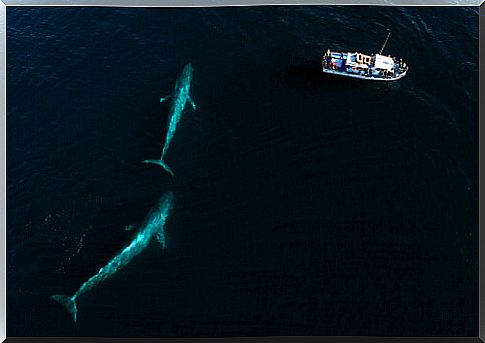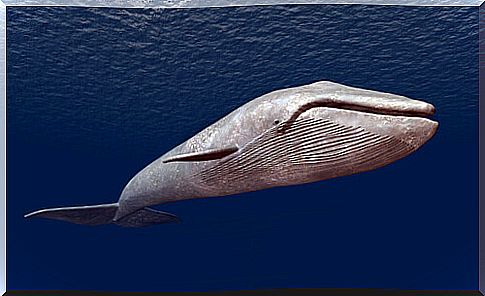The Reproductive Habits Of The Blue Whale

The blue whale is a marine mammal that belongs to the cetacean family. Among its most outstanding peculiarities you should know that the reproductive habits of the blue whale are extraordinary, which is why we will discover them in the following article.
Also known as the blue fin whale, it is an animal that reaches sexual maturity between five and seven years of age. The gestation period of the whale lasts an average of 10 months, in which the female can give birth to only one baby. In addition, you must take into consideration that the period is related to the feeding and migration cycle of the species.
Likewise, the blue whale frequents waters around the world, although it prefers cold waters, especially during the feeding season. Also, it is rarely found in warm waters except during the breeding season.
Reproduction of the blue whale
During reproduction, the male and female perform a careful ritual, as they rotate, communicate, dive, and return to the surface several times. Until finally, the male thrusts his penis into the female’s vulva.
As for pregnancy , you should know that it usually lasts between 10 and 12 months. What is considered a relatively short period for an animal of this size. As a general rule, a litter has only one newborn, but twins are possible.

When the baby blue whale is born, for the first seven months it is fed exclusively on breast milk. You can drink about 200 kilograms and gain up to 90 kilos per day. As soon as weaning occurs, the young whale follows the migratory cycle of its species.
The females go into heat several times a year. It is during this period that she will look for a mate that she perceives as the strongest, as this should give her offspring the best chance of survival.
Once the mating season is over , the whales will return to their foraging grounds and continue a life of feeding or hunting until the young are ready to hatch.
Reproductive organs
The reproductive organs of whales are inside their bodies. Mating takes place in warm or temperate waters and is done against the belly.
Females can have one offspring per year, throughout their lives, which usually last 50 years. In that sense, you must take into consideration that the female whale could have a total of 40 cubs throughout her life, although this rarely happens.

Unfortunately, not all puppies survive and females are not always able to conceive throughout their lives. The reproductive success of a female will depend on her physical qualities, available food, environmental conditions and the presence of predators.
On the contrary, males can have several young a year in case they have the opportunity to mate with several females. They do not usually take care of their babies, but it is the females who provide the necessary care, or even other members of the family.
Birth of the blue whale
The baby blue whale can come into the world by poking its head or tail first. When the birth occurs, it must rise quickly to the surface to take a first breath and thus avoid drowning, and then return to its mother immediately.
During the first months of existence, newborns grow three to four centimeters and gain 81 kilograms per day. They can be seven meters long at birth and weigh two to three tons. The lungs do not contain air, which is why the newborn does not float.
As for breastfeeding, babies usually breastfeed once or twice a day from the female’s nipples. The milk is rich and creamy, while the duration of breastfeeding is eight months and does not depend on the size of the whale. This period is a privilege for the transmission of information between mother and child.
Finally, you should keep in mind that the reproductive habits of the blue whale follow a specific set of fascinating actions and behaviors.









